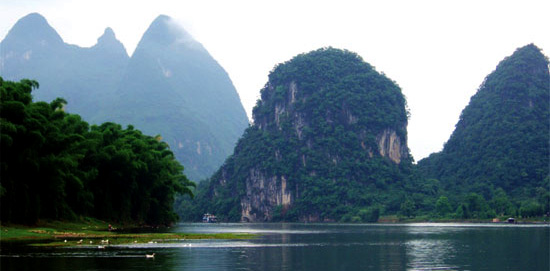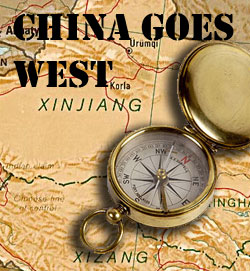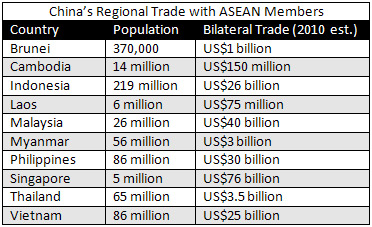Guangxi: China’s Direct Link to Southeast Asia

 Aug. 23 – Guangxi, in China’s southwest, has the geographic advantage of being in close proximity to other Southeast Asian countries, the world class financial center of Hong Kong, and Guangdong Province, China’s wealthiest and its largest manufacturing base. Bordering Vietnam to the west, Guangxi is connected to Hong Kong and Macau by the Xi River, and is China’s only western region with open sea port facilities. The government has placed emphasis on the importance of the province and its development in the coming years and even more so when it comes to future China-ASEAN cooperation. Trade agreements signed between China and ASEAN, as well as with many ASEAN member countries directly, including the scrapping of inter-regional tariffs, are in the process of re-energizing Southeast Asia and massively increasing trade. Guangxi is set to massively benefit from this.
Aug. 23 – Guangxi, in China’s southwest, has the geographic advantage of being in close proximity to other Southeast Asian countries, the world class financial center of Hong Kong, and Guangdong Province, China’s wealthiest and its largest manufacturing base. Bordering Vietnam to the west, Guangxi is connected to Hong Kong and Macau by the Xi River, and is China’s only western region with open sea port facilities. The government has placed emphasis on the importance of the province and its development in the coming years and even more so when it comes to future China-ASEAN cooperation. Trade agreements signed between China and ASEAN, as well as with many ASEAN member countries directly, including the scrapping of inter-regional tariffs, are in the process of re-energizing Southeast Asia and massively increasing trade. Guangxi is set to massively benefit from this.
Rail links from Guangxi to what was then French Indochina (Vietnam, Cambodia and Laos) date back to pre-World War II times, while interestingly, the province did not actually join the People’s Republic until two months after the founding of the country in 1949. Guangxi, along with Yunnan, had contemplated independence, based mainly on the Zhuang culture, one of the largest ethnic minorities in modern China. The Zhuang, with a distinct, separate history and culture to the nationally dominant Han Chinese, are the reason why Guangxi is one of China’s autonomous regions today, a status conferred in 1955.
Guangxi’s infrastructure links with Vietnam date back in part to the Vietnam War, when transportation infrastructure was laid down to send supplies to the Viet Cong during their war against the United States. Fangchenggang Port was extensively developed during this conflict, and remains today as a major regional shipping and trade hub between Guangxi and Vietnam, so much so that Vietnam, and not other Chinese provinces, is Guangxi’s largest trading partner today.

Guangxi’s location gives it the unique benefit in China of having major access to both mainland and Southeast Asian markets, giving it a considerable share and a stake in China’s development of ASEAN trade, which is approximately some US$205 billion in total annual trading value. Both this trade and a growing regional tourism industry have forced its transportation system to improve, and the government has just allocated RMB150 billion (US$22 billion) to improve infrastructure in the Beibu Gulf Economic Zone (compare this with Inland Regional Infrastructure development projects). The Beibu Gulf Economic Zone includes the ports of Fangchenggang, Beihai and Qinzhou, as well as the provincial capital of Nanning. The investment will include expansion of port facilities at Fangchenggang from the current 60 million tons to 100 million tons by 2015, in addition to the upgrading and development of road and rail links from each of the ports to Nanning and to the Vietnamese border.
This is also being linked in with extensive highway construction that will allow other inland Chinese cities better access to Guangxi’s ports. In 2007, the province invested RMB18 billion in its transportation system including 300 kilometers of new highways, and land transportation hubs at Nanning, Liuzhou and Guilin. In accordance with the western region development strategy, the local government is prioritizing the construction of highways within the region, especially as Guangxi is part of the Southwest Sea Passage Expressway that will allow Chongqing and other cities in Sichuan province to have a direct link to the sea and improve their global export potential. Guangxi, meanwhile, will pick up the trading and shipping income.
Rail has and is also being extensively upgraded. Over the past four years, some RMB100 billion has been invested to improve the railway infrastructure. The Nankun rail line into Yunnan province is one of the most modern in the country in terms of trains and tracks, while the Nankun railway project links Kunming and Nanning and offers an alternative transportation route between Guangxi, Guizhou and Yunnan. Nanning East Railway Station, which is currently being built, will be over 160,000 square meters, and should be ready by 2013. Its annual handling capacity will be 34 million passengers by 2020. These routes interconnect via Kunming directly to Hanoi in Vietnam, and then onto the Southeast Asian rail network, leading ultimately to Singapore.
Guangxi has three major airports: Guilin, Nanning and Beihai. There are also airports in Liuzhou, Wuzhou and Yulin. The region has 22 international and domestic airlines with regular flights to major cities such as Beijing, Shanghai and Hong Kong, and has also opened direct airlines for Beijing–Nanning–Hanoi, Vietnam and Guilin to Fukuoka in Japan. Guilin airport is one of China’s busiest and most efficient, with the city, set in one of China’s most beautiful areas, also possessing a major international tourism industry and infrastructure. Nanning is also expected to become an international aviation hub, with flights to Europe being considered, both for developing trade and also Guilin’s regional tourism. Nanning airport is currently being redeveloped and is also scheduled to be completed by 2013, when annual passenger capacity will have been increased to 15 million. To compare, that is double the current capacity of Berlin, and about the same as San Diego. The time to invest in Nanning is about now; when the air and rail terminals are completed, property prices will rise.
Guangxi also has inland river ports in Nanning, Wuzhou and Guigang, and these link-up with the provincial seaports at Beihai, Qinzhou and Fangchenggang. The island of Wuzhou in particular has good harbor facilities and is strategically capable of handling distribution to and from Guangxi, Guizhou and Sichuan. The Pearl and Xinjian rivers to the east, servicing Guangdong, also have an efficient transportation network with Guangxi being just a short coastline away to their estuaries on the Gulf of Tonkin.
Tourism is also expanding westwards to the Vietnamese province of Thua Thien. There, Hue is being developed, with a sea tourism route linking Beihei of Guangxi and Chan May port in Hue. The sea travel route expands the existing route between Beihei and Halong Bay in Vietnam’s northern province of Quang Ninh, where already hundreds of cruise ships bring in tourists by the thousands. The route will allow cruise liners to sail on to the Chan May port in Hue after stopping over in Halong Bay, itself a world famous tourist destination.
The major industries in Guangxi are sugar processing, metallurgy, chemicals, engineering, electronics, pharmaceuticals and cement production. The region is the leading producer of sugar in the country, producing more than 200 million tons annually.
The region’s light industries produce textiles, paper, flour, silk, leather, matches, chemicals and pharmaceuticals, as well as sandarac gum, sugar, dyestuffs, and oils and fats. Other heavy industries include the iron works and steelworks at Liuzhou, machinery production at Nanning and Wuzhou, and the cement works at Liuzhou. Pinyang alone produces ceramics, fans, felt caps, copperware, combs, brushes and straw bonnets. Agriculture is also a key industry in the region. Major grain crops include rice, maize, wheat, and sweet potatoes. The leading commercial crops include peanuts, sesame, ramie, tobacco, tea, cotton, and indigo. Guangxi is also a major producer of fruits; most notably pomelos, tangerines, mandarin oranges, lemons, lychee, pears, papayas, bananas, pineapples and water chestnuts. There are two annual harvests of rice while the timber industry produces sandalwood and cork. Fishing is also another important local industry.
Total industrial production value reached RMB117.6 billion for 2009, while total trade for Guangxi rose 7.3 percent to US$14.2 billion the same year. However, Guangxi’s trade with ASEAN rose faster than its domestic trade with China, at a rate of about 24.3 percent.
There are two technology related zones in Nanning, border economic cooperation zones in Dongxing and Pingxiang, a high-tech zone in Guilin, an export processing zone and a national tourism zone in Beihei, and an economic zone in Yongning.
Nanning High and New-Tech Industrial Development Zone
The zone is located in the suburb of Nanning city and is approved by the State Council to develop capital-intensive and high value-added technologies. Foreign investments are encouraged especially in the areas of bio- engineering, new building materials and information technology.
Guilin High and New-Tech Industrial Development Zone
This was the first state-level high and new-tech industrial development zone in Guangxi. Since 1995, the zone’s utilized foreign investment exceeded US$56.6 million and attracted investments from top enterprises such as NEC and Nokia.
Beihai Silver Beach Tourist Holiday Zone
Approved by the State Council in October 1992, it is one of the 11 state-level vacation and tourism development zones with a total investment of more than RMB390 million.
Pingxiang Border Trade Development Zone
The zone was approved to specifically develop border trade with Vietnam. There is an international railway and highway running through the 7.2 square kilometer area. Customs, exporting specialists and transport companies are prominent here.
Wuzhou Export Goods Processing Area
Established in September 1991, it is designed to develop high-tech export goods, as well as automobile components, assembling, and electronics.
Dongxing Border Trade Development Zone
Like the Peingxiang Border Trade development zone, it was approved to encourage more border trade with Vietnam and has rapidly been developing bilateral trade.
Qinzhou Port
Qinzhou was developed in the late 1990s and container output has now reached some 109,000 TEUs, a rise of 140 percent in the first half of this year. Cargo throughput reached 14.16 million tons, an increase of 56.1 percent. There are plans to develop the total capacity to 100 million tons next year. Hong Kong is Qinzhou’s main destination for cargo, with ASEAN destinations second. The port also includes Qinzhou Free Trade Port, with a planned area of 10 square kilometers, and capacity to handle 1 million TEUs by 2012. A cargo park is also being built to have a capacity of 50,000 tons by the end of next year. Qinzhou has specifically been developed to cater for handling China-ASEAN trade, and is likely to prove to be a significant location in the very near future.
Beihai Port
Beihai port serves as the major point of trade between China and Southeast Asia. It currently links 220 ports in over 70 different regions. The port has several container berths, capable of handling ships from 20,000 dwt to as large as 50,000 dwt for either bulk or container transport. The eight specialized rail lines in the port connect on to all the major lines in the area. The port is a developing hub for shipping oil between Southeast Asia and China. It currently has as 16 oil tanks with a capacity of more than 100,000 tons of oil. Other major products are chemicals, metal and nonmetallic ore, woodchips and fertilizers. In addition, Beihai port also helps serve its tourism industry with a current capacity of 300,000 passengers annually, however development plans expect to double this by 2015.
Guangxi then represents a significant opportunity for both Chinese and international businesses in China wishing to sell to or trade with ASEAN. Like most of China’s border provinces, it is the expansion of direct bilateral and multilateral trade that is driving the economy forward, and Guangxi has certainly been investing wisely in its infrastructure to cater for this. Nanning remains linked to Southeast Asia and especially trade with Vietnam, while Guilin remains a much loved tourist destination. I expect the region to develop fast over the next decade, and with ASEAN so close by and also booming, Guangxi as a provincial investment looks an excellent play to consider. The opportunities in Guangxi as relate to markets throughout ASEAN are there to be developed.
Parts of this article are excerpted from the China Briefing Business Guide to South China and the Greater Pearl River Delta.
Chris Devonshire-Ellis is the principal and founding partner of Dezan Shira & Associates. The firm has 18 years of foreign investment experience throughout China and Vietnam, maintaining 10 offices in China, and one each in Hanoi and Ho Chi Minh City. For assistance and advice over foreign investment laws, taxes and incentives and conditions in trade between China and Vietnam please contact the firm at info@dezshira.com. Chris also contributes to India Briefing , Vietnam Briefing , Asia Briefing and 2point6billion
Related Reading
Guangxi Clarifies Tax Management on Major Construction Projects
The Complete “China Goes West” Series
Go West
(Includes complimentary back issues of Western Region themed editions of China Briefing Magazine)
Vietnam Briefing
(Daily business news, foreign direct investment, legal, tax and overviews of business in Vietnam, together with regular quarterly magazine)
Nanning City Guide
(Complimentary PDF download)
Business Guide to South China and the Greater Pearl River Delta
(Includes a detailed overview of South China, including Hong Kong, Macau, and the provinces of Guangdong, Fujian, Guangxi and Hainan, in addition to concise introductions to the cities of Dongguan, Foshan, Fuzhou, Guangzhou, Haikou, Huizhou, Nanning, Shantou, Shenzhen, Xiamen, Zanjiang, Zhaoqing, Zhongshan and Zhuhai.)
- Previous Article China Encourages Further Use of Foreign Capital
- Next Article SASAC Releases 2009 China State Owned Enterprise Performances





























